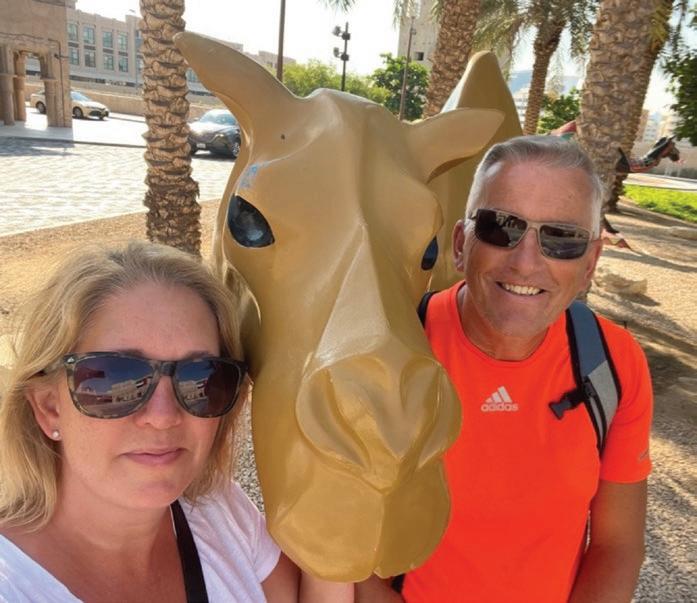
3 minute read
World Congress of Gastroenterology –Dubai December 2022 PPI’s vs P-CABs for treating GORD
Kirsten Arnold NZgNC committee member treasurerofnzgnc@gmail.com
In December 2022 I had the opportunity to attend the World Congress of Gastroenterology, which was held in Dubai, UAE. Grateful thanks to the NZgNC for providing me with funding.
Advertisement

Dubai is an amazing city of opulence and extremes. Everything in the city is bright, shiny and often huge!! The Burj Khalifa has been the tallest building in the world since January 2010. In contrast to the opulence of the central business district and Jumeirah, there is the Old Town which is a fascinating mix of homes, mosques, and markets – with every spice you could ever want, in abundance!
The conference itself was held in the (slightly ominously named) World Trade Centre. Despite its unfortunate moniker the conference venue was well appointed and thankfully well air conditioned! I have recently branched out into 24-hour pH monitoring, so I attended some informative sessions on the diagnosis and treatment of Gastro Oesophageal Reflux Disease (GORD). In one of these sessions was a presentation by Professor Ronnie Fass from Case Western Reserve University, regarding the use of a newer class of medication to treat reflux called potassium-competitive acid blockers, or P-CABs.
In New Zealand reflux is treated primarily with proton pump inhibitors (PPI’s) such as omeprazole, lansoprazole and pantoprazole. These medications work on the gastric parietal cells by binding to specific elements within the cell which are required for acid production. PPI’s have shown good efficacy and safety profiles in treating acid reflux conditions; however, they require enteric coating to survive in the stomach and are prodrugs so must be absorbed into the parietal cells before they can inhibit acid expression. This is why they have a 30-minute onset to action time, meaning that for optimal dosing the patient must take the PPI at least 30 minutes prior to eating (Savarino et al, 2021).
P-CABs also target the gastric parietal cells; however they are acid stable so do not require enteric coating, and they are not a prodrug. They therefore act immediately on the proton pump and do not require administration 30 minutes before a meal to be effective. They also have a longer half-life meaning they not only work faster than PPI’s but will also have a longer duration of action (Wong, Reddy & Patel, 2022).
In terms of safety, studies have been done in the most prescribed P-CAB, vonoprazan and these have shown excellent short- and medium-term safety comparable to that of PPI’s. A 2017 Japanese meta-analysis compared vonoprazan to lansoprazole in GORD and showed similar safety outcomes between both treatments (Wong et al, 2022). Studies are continuing and as this class of medication is more widely used, long term safety data will become available.
Proton Pump Inhibitors (PPIs) Potassium Competitive Acid Blockers (P-CABs)
Pro-drugs that need to be transformed to the active form
Binding covalently to H+-K+ ATP-ase
Irreversible binding to the proton pump
Full effect after 3-5 days
Affected by genetic polymorphism
Pharmacodynamic effect greater during the daytime
Direct action on H+-K+ ATP-ase
Binding K+ site of H+-K+ ATP-ase
Reversible binding to the proton pump
Full effect after the first dose
Not affected by genetic polymorphism
Pharmacodynamic effect lasting for both the daytime and nocturnal hours
Wong, N., Reddy, A., & Patel, A. (2022). http://doi.org/10.2147/DDDT.S306371
In my practice, the primary reason that patients come to have a pH study is because their reflux symptoms have not resolved with maximum dose PPI treatment. Often these patients are considering anti-reflux surgery such as a Nissen Fundoplication which is a significant procedure and not without its risk and downsides. It can be difficult for people to remember to take their medication at least 30 minutes before a meal and this will be one reason that PPI therapy is ineffective. It has also been reported in some studies that between 19-44% of the GORD population may be refractory to PPI treatment, with either partial or complete lack of response to standard dosing (Savarino et al, 2021).
The other indication for PPI use is in the eradication of helicobacter pylori (HP). Currently in New Zealand we treat HP with “triple therapy” which is usually omeprazole, and two antibiotics (clarithromycin plus amoxycillin or metronidazole) given in combination for a 14-day period.

Sometimes one treatment is not sufficient to eradicate HP and patients require a second course. This increases their antibiotic exposure which is a risk for developing antibiotic resistance. A meta-analysis of randomised controlled trials published in 2019 compared PPI based triple therapy with vonoprazan based triple therapy. This showed combined HP eradication rates of 91% in the vonoprazan group and 75% in the PPI group. This correlates with another large study that showed eradication rates of 91% when vonoprazan was used, compared with 68% to 78% in the group using PPI based triple therapy (Wong et al, 2022).
All of this sounds very promising, but a quick search of the New Zealand formulary tells me that these medications are not yet available in this country. Hopefully over time, as P-CABs become more mainstream overseas, we may see them introduced here. Obviously the longer these medications are used, the more long-term safety data will be available. I for one would like us to be able to offer PPI refractory patients another option before they head towards surgery.
References:
• Savarino, V., Marabotto, E., Zentilin, P., Demarzo, M.G., de Bortoli, N., & Savarino, E. (2021). Pharmacological management of gastro-esophageal reflux disease: An update of the state-of-the-art. Drug Design, Development and Therapy (15), 1609-1621. https:// doi.org/10.2147/DDDT.S306371
• Wong, N., Reddy, A., & Patel, A. (2022). Potassiumcompetitive acid blockers: Present and potential utility in the armamentarium for acid peptic disorders. Gastroenterology & Hepatology, 18(12), 693-697. https://doi.org/10.2147/DDDT.S306371

